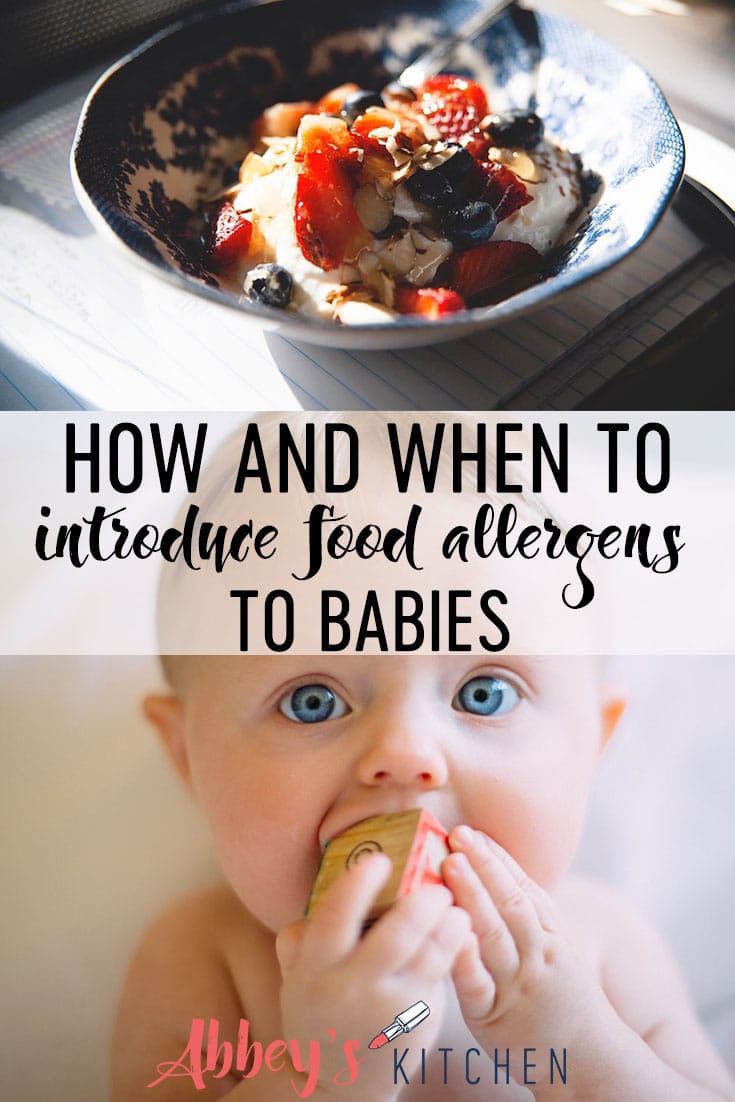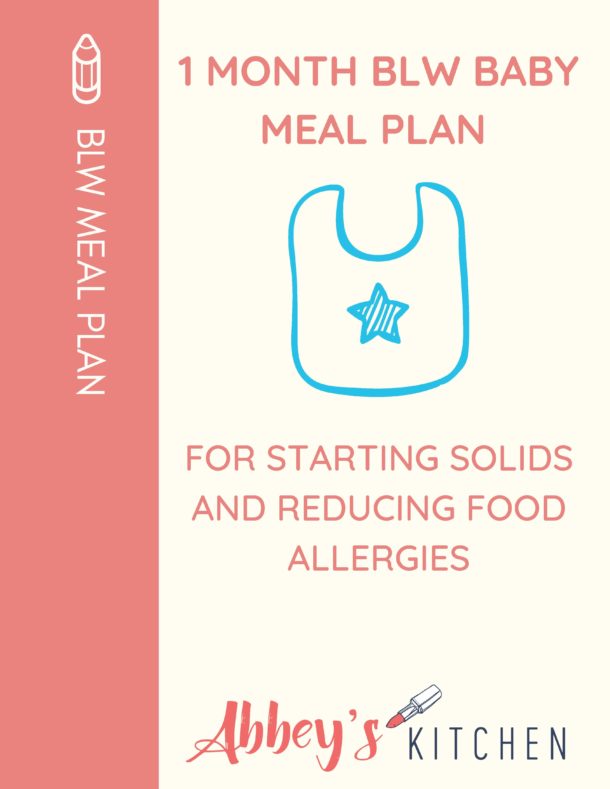We look at the new guidelines on allergen introduction and discuss how and when to introduce food allergens to babies with baby led weaning or spoon-feeding.
With common food allergies on the rise, it’s not surprising that parents are worried about when and what to feed their kids. Not only are food allergies a bit of a drag (I mean, missing out on Reese’s PB cups seems criminal), but they can also be deadly. As a new mom, the thought of my kid being sent out into the world with a fatal allergy is unbearably terrifying. Obviously parents, like me, want to do whatever we can to reduce the risk of food allergies developing and looking at the new guidelines is the place to start.

Peanuts are one of the top 8 allergens along with eggs, milk, mustard, seafood, sesame, soy, sulfites, tree nuts and wheat, and are probably the one that parents worry about the most. Up until 2017, the pediatric recommendations were to introduce peanuts to children after 3 years so that their gut and immune system are more developed and ready to digest the peanut protein. However, new guidelines by Food Allergy Canada revealed that the introduction of peanuts at a much younger age (4-11 months) may actually be beneficial and that waiting actually increased the risk. Gah! How frustrating for parents of kids with allergies to see these recommendations change! In our first post we looked at some possible reasons why allergies may be on the rise and how you can try to reduce the risk for your baby, so today let’s dive into how and when to introduce food allergens to your baby.
Let’s talk about the landmark study that informed these new recommendations.
PEANUT ALLERGIES: LEAP Study
The Leap study was a randomized controlled clinical trial designed to figure out the best way to prevent peanut allergies in young children. Their hypothesis was that introducing food early (before 6 months) can reduce the development of common food allergies by inducing food tolerance. The study included 640 children between the ages of 4 and 11 months that had an elevated risk of having a peanut allergy. These children were randomly assigned to two groups:
- Complete Avoidance Group (not ingesting peanut-containing foods)
- Consumption Group (consume peanut snack with three or more meals per week).
The findings from the study revealed that 17% of children who avoided peanuts developed a peanut allergy by the age of five, while 3% of children who consumed peanuts developed a peanut allergy by age five. I went into more detail on the study and the new guidelines in this post but to recap, here are the new guidelines for introducing peanuts.
The LEAP Study’s Recommendation:
Guideline 1: If your baby is at high risk (severe eczema, egg allergy, or both), they should have peanuts as early as 4 to 6 months.
Guideline 2: If your baby has mild to moderate eczema, they should have peanut containing foods around 6 months.
Guideline 3: If your baby has no eczema or any food allergy, you can freely introduce peanut containing foods into their diet but a lot of pediatricians are interpreting this as to also introduce regularly.
The hope is that these guidelines will help to drop the prevalence of peanut allergies, especially in high risk infants.
So what about other common food allergies?
Here in North America, the top food allergens in order of most common to least are:
Peanuts
Tree nuts
Shellfish
Soybeans
Fish
Milk
Eggs
Cereal Grains
While we don’t have profound research on all of the allergens like we do for peanuts, we do have some other interesting new research to draw upon. Namely, the EAT study.
EGG ALLERGIES: Enquiring About Tolerance Study
The Enquiring About Tolerance (EAT) study explored allergen exposure through breast milk starting at 3 month infants – specifically, milk, peanuts, egg, sesame, whitefish and wheat. This group was compared to a standard group, who were exclusively breastfeed until 26 weeks and exposed to allergenic foods at 6 months. The groups were regularly monitored for allergy development until 3 years of age.
When comparing the allergen early introduction (at 3 months) and standard introduction (at 6 months) groups, the results showed that early introduction of allergens before 6 months did not affect breastfeeding performance or the infant. The study actually found that women continued to breastfeed alongside solid food consumption. But by the age of 3, the early introduction group showed a lower incidence of allergies. Specifically, there was a 67% lower risk of food allergies in the early introduction group. While they tested all of the allergens I mentioned above, they found that early introduction of egg and peanut had the most profound effect.
The EAT study also found that consuming small amounts of the allergenic foods regularly can help prevent food allergies. One thing I want to highlight, however, is that babies don’t stop drinking breastmilk or formula while being exposed to new foods- these foods are simply complimentary to their milk-based diet.
So what’s the bottom line from the EAT study? Introducing allergenic foods before 6 months to breastfeed infants is safe and may even reduce the risk of food allergies. More specifically, introducing peanut and egg products within 4-6 months may help reduce the risk of allergies.
GLUTEN ALLERGIES
Another important study, inspired by the DAISY study, found that infants exposed to gluten at 3 months had a 5-fold increased risk of celiac disease in comparison to those exposed between 4-6 months. Further, infants exposed to gluten at 7 months had an increased risk of celiac disease. Gradual introduction of gluten through breastfeeding reduced the risk of celiac disease into early childhood, as well. These findings are aligned with the European Society for Paediatric Gastroenterology, Hepatology and Nutrition recommendation to avoid both early (before 4 months) and late (after 7 months) introduction of gluten, and to introduce gluten while the infant is still being breast-fed.
So what’s the bottom line from this study? Gluten containing foods can be introduced to babies between 4-6 months while continuing breastmilk or formula to reduce the risk of celiac disease.
MILK AND DAIRY ALLERGIES
You may have heard that you’re not to introduce cow’s milk to baby until they’re 1 years old, but that shouldn’t be interpreted as NO dairy at all. The recommendation is that we don’t want to start giving our baby a full bottle of cow’s milk (because we don’t want it to replace formula or breastmilk), but introducing yogurt, cheese, or small amounts of cow’s milk baked into foods as early as 6 months is nutritious and advantageous.
There are a few things, however, to consider. One, you want to make sure that the options are always pasteurized to prevent any risk of listeria. And two, dairy can interfere with iron absorption and since getting enough iron is our top priority for baby when starting solids, it may also be preferable that you hold off on offering a lot of dairy (or other calcium rich foods) until your baby is enjoying a wide range of iron rich foods. When you do introduce dairy, try serving it at a different meal from meat or other iron rich foods to prevent the absorption interference.
How does introducing a food early reduce the likelihood of future allergy?
We may not know for sure, but the Dual Allergen hypothesis states that allergic sensitization can occur through exposure of food items through the skin and that by consuming the potential allergen (food) early, the risk of allergic sensitization is reduced.
How does exposure of food items through the skin happen? Every day in our environments we are exposed to a variety of different food particles. This leads to something called “low-dose exposure to environmental foods.” This exposure then penetrates our skin and causes an immune response, which may increase the risk of allergies.
Recommended Protocol for Introducing Food Allergens
So now we know where these recommendations are coming from, let’s talk about HOW to introduce allergens. According to the Canadian Society of Allergy and Clinical Immunology, a baby is ready to be introduced to peanuts when they are ready to be introduced to complementary foods. The current guidelines are largely related to peanuts, as LEAP study looked at peanut allergy, but the Canadian Pediatric Society recommends other allergenic foods can be introduced at 6 months in an age appropriate way. Here are some specific steps for introducing peanuts to your baby.
Peanuts should be introduced for the first time when your baby is healthy and at home. It is important to introduce allergenic foods during the daytime to monitor the infant’s response. Also, one adult should be present to give their full attention to the baby, and then to be available for another 2 hours afterward. Here’s the recommended protocol:
- Take 2 teaspoons of smooth peanut butter and add 2-3 tablespoons of hot water and stir until dissolved and well blended. Allow to cool.
- This mixture can be offered alone, or added to cereal, pureed fruit/veg, other soft foods.
- Once the portion is ready, offer a small amount to infant on the tip of a spoon. Wait 10 minutes.
- If no symptoms (see the list below) develop, continue feeding the peanut butter mixture.
- Once peanut is introduced and tolerated, it should be kept in the diet on a regular basis to maintain baby’s tolerance. Babe should consume 1.5 tsp of peanut butter over 3 or more feedings per week.
It’s best to introduce one allergen at a time and then wait two days before introducing another common allergen. This helps you reduce any detective work in the event you do have a reaction and you can quickly narrow down the culprit.
Now that we have a general idea on how to introduce allergens, here are some ideas for incorporating all of the different to allergenic foods into your baby’s diet, either through spoon-feeding or baby-led weaning.
What Does an Allergic Reaction Look Like?
An allergic reaction can appear just a couple of minutes or a couple of hours after an allergen exposure. Some of the most common signs and symptoms include:
- Skin: hives, swelling, itching, rash, redness
- Stomach: nausea, pain, diarrhea
- Respiratory: coughing, wheezing, shortness of breath, chest pain, throat tightness, nasal congestion, hay fever-like symptoms (runny nose, watery eyes, sneezing)
- Heart: dizziness, shock, weak pulse, passing out
- Emotional: anxiety, headache, metallic taste, cramps
If you notice your baby is possibly experiencing an allergic reaction, immediately call 9-1-1 and/or use an EpiPen (if available).
Is that rash an Allergic Reaction or just Contact Irritation?
As a new mom now feeding my son solids, I would anxiously watch for every little sign or symptom on the list I just went through. Occasionally I would see some mild redness or little bumps on my son’s face and worry if something he ate had triggered a reaction. If this sounds like you, don’t panic.
It’s not recommended to place the food on the skin first, as the food may cause an irritant effect that could be misinterpreted as an allergic reaction. Skin contact with a food (e.g. applying a food to the skin first to see if there are any skin changes) is not a way to determine if it will be tolerated when it is eaten according to the Canadian Society of Allergy and Clinical Immunology.
But the Australian society of clinical immunity and allergy suggests rubbing food inside the infant’s lip to observe for any immediate reaction. If no reaction occurs, more food can be gradually given.
Final Thoughts on How and When to Introduce Food Allergens to Babies
Food allergies are still a mystery as to why they occur in some individuals and not others. But I hope that I have helped simplify the allergen introduction process and reduced your anxiety about the best way to introduce food allergens to babies. Whether you’re choosing to spoon-feed or feed with baby-led weaning, there are a number of ways you can introduce those food allergens to help reduce the risk of a reaction.
Now mamas, let me know – how did you introduce food allergens to your babies?
Leave me a comment below and share some of your knowledge!
Contribution By:
RD2B Sumeet Chopra and Hannah Wilson & Sofia Tsalamlal, RD, MHSc Nutrition Communication
Updated on October 19th, 2020

Abbey Sharp is a Registered Dietitian (RD), regulated by the Ontario College of Dietitians. She is a mom, YouTuber, Blogger, award winning cookbook author, media coach specializing in food and nutrition influencers, and a frequent contributor to national publications like Healthline and on national broadcast TV shows.











Emma says
Are canned smoked oysters sage for baby to eat ?
Amanda Jones says
My husband has food allergies, so given our higher family risk, we wanted to introduce allergens early for our baby. At first, we tried going about it ourselves, but it was tough to introduce effectively when we started at 4.5 months (most everything didn’t really make it into our baby’s mouth). So we actually found a solution with Ready, Set, Food, which allowed us to introduce the allergens in a bottle of breast milk, and we have been using their system for our little one for a few months now. Good news is that the kiddo has had no food allergies develop since we started, which we’re super grateful for. I hope that all parents who are looking to protect their baby from food allergies will do early allergen introduction in some form!
Abbey Sharp says
Glad you found something that works for you! Thanks for sharing 🙂
Olga Martinez says
OMG! Thank you very much, I was doing a lot of reading about this, and now my baby just turned 7, I’m doing the introduction of solids by both ways, spooning and blw, I thought my baby was having an allergic reaction to something because he got some rash in his chest and below his chin and now I know is the reaction to his skin being in contact with food, but either ways I will consult his pediatrician. Thank you!
Abbey Sharp says
I would definitely consult with your pediatrician. Thanks for sharing 🙂
Angela Cardamone @marathonsandmotivation.com says
This all such great information! I remember doing a ton of reading about this when I was introducing my first child to new foods!
Abbey Sharp says
Thanks Angela!
Farrah says
Great post! There was so much waffling on when to introduce food allergens over the past several years–this is pretty much what I’ve been counseling to my peds patients (or at least, to their parents, haha)!
Abbey Sharp says
Totally. Lots of debate around this
Deborah Brooks says
wow! So much to think about! None of this info was out there 20 years ago when I had babies
Abbey Sharp says
Right! We’ve come a long way!